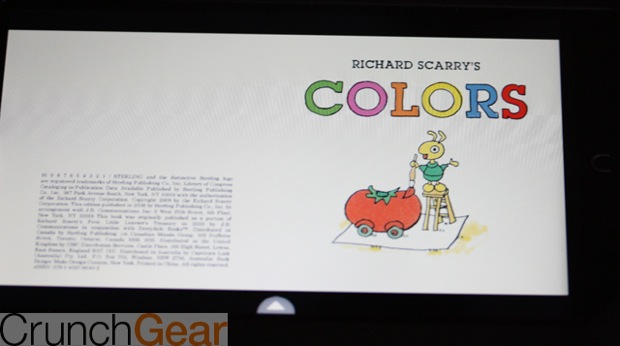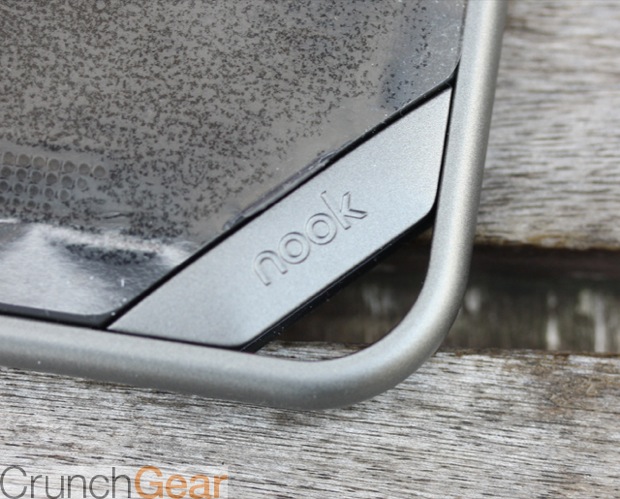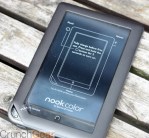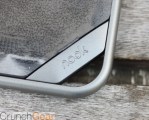
Short Version:
The Barnes & Noble Nook looked like an also-ran until they came out with the first mass-market color e-reader, the NookColor, one of the first LCD e-readers worth considering. Although the price says “Why not just buy an iPad?” the features and design say “Let’s give this thing a second look.”
Features:
- 7-inch color touchscreen
- 8GB Memory Built-in
- MiniSD Slot
- Wi-Fi
- $249
Pros:
- Bright screen
- Nice size and weight
- Great sharing experience
Cons:
- B&N Store is limited
- No cellular connection
- Screen washes out in sunlight
The Device
First things first: The NookColor is an e-reader. It is not an Android device in the same way an ATM running Windows CE is not a “Windows” device. It is, in short, B&N’s own trunk of the Android code molded to supply very specific functionality. A corollary to this that this is not a tablet. You can’t edit documents – yet – and you can’t play games beyond a few basic, non-graphics intensive puzzles. This is not a computing device, it is a reading device.
With that in mind, we can easily see where this device diverges from the current tablet/e-reader marketplace. First, it is small, unlike the Samsung Galaxy Tab and the iPad, and it uses an LCD screen, unlike the Kindle and the original Nook. The goal here is to allow you to buy, read, and share e-books. Anything else is a distraction.
The device initially connects to the B&N Nook store and allows you to browse books, newspapers, and magazines via a touchscreen interface. It has 8GB of memory built-in – enough for 6,000 books or so – and it can play some video and music files, in addition to video and music embedded in some enhanced e-books. Again, this is ancillary to the main goal of displaying text.

To read standard books you simply slide your finger left or right to turn pages. There are no other physical buttons, which could be a concern for folks with vision or movement problems.
The NookColor can display standard e-books or enhanced versions of standard books as well as color children’s books. The children’s books appear just as they would on paper, with rich color illustrations. There is also a “read aloud” feature for lonely kids whose parents don’t love them. You can pinch-zoom into picture books to read the unusually small fonts found in many of these books but once you’re pinched in you can’t turn the page with a quick swipe until you’ve zoomed out. This is a minor, if annoying, bug.
The newspapers are a real dud, at least right now. The New York Times appears just as it has on the Kindle and Nook for years now – a list of headlines and then a series of long articles. There is no interface for tapping articles in a newspaper layout right now although this is expected soon along with the article view in the magazines available in the Kindle store. This will truly differentiate things for the NookColor as the current model asks users to download a separate app for each newspaper and magazine on devices like the iPad. Once the magazine/newspaper interface is perfected, I think the NookColor will be an impressive tool for reading the morning news.
 Content factors aside, the Nook color is physically unimpressive. It is small, light, and innocuous with a central “N” button at the bottom center of the screen and power and volume buttons on either side. The wacky “belt loop” thing on the left corner is clearly a safeguard against clumsiness because, when it comes down to it, this is still a fairly large pane of LCD and glass. Interestingly, B&N doesn’t include a wrist strap a la the Wii although I suspect some OEM out there will create leather fashion straps sooner than later.
Content factors aside, the Nook color is physically unimpressive. It is small, light, and innocuous with a central “N” button at the bottom center of the screen and power and volume buttons on either side. The wacky “belt loop” thing on the left corner is clearly a safeguard against clumsiness because, when it comes down to it, this is still a fairly large pane of LCD and glass. Interestingly, B&N doesn’t include a wrist strap a la the Wii although I suspect some OEM out there will create leather fashion straps sooner than later.
The interface focuses on the process of reading books. You power it up, unlock the screen, and select a book. A persistent menu at the bottom allows you to search for more books to buy or visit the web if you so choose. The browser is average at best.
You can create “shelves” of books that contain certain titles (a “horror” shelf can contain new books by Stephen King and Sarah Palin) while the main “home” screen works like the Android home screen with a set of three panes that can hold various titles in stacks. All of your books hang out at the bottom of the home screen and you can set the background to your own photos if you so desire. This is a bit confusing because the “library” page shows all of your books in one layout, either by date added or title, and the home page shows a sort of organic view of the same titles. Then you have the “shopping” view that offers multiple lists of potential titles including selections from the B&N top 100 and the New York Times bestseller list.
Another problem is that there is no visible “back” button for returning to screens you’ve just visit. It is a one-way system and very rarely is there a visible way “back” to the main pages for each of the features. If this sounds confusing it’s because it is. The persistent menu always keeps you on an even keel, though. However, you must forget everything you think you know about mobile OSes and allow for the Nook’s own special interface.
You can also share almost any book you’ve bought. Using LendMe, you can share books for up to 14 days (they revert back to you when you’re done) and you can request books from friends who also have Nooks. This is a big differentiator when compared to the Kindle store.
What Makes It Different
The NookColor isn’t an iPad. It doesn’t work like an iPad and it will never have the same developer buy-in as the iPad. It is, for the most part, a more expensive Kindle with a color screen. When you look at the Kindle you don’t think “I want to play 3D games on this!” The same goes for the NookColor. It’s just not built for power.
Unlike the Galaxy Tab, for instance, the Nook is pocketable and the battery lasts a good few days before needing a recharge. Unlike e-ink screens, text is deep black on bright white, which improves the reading experience. However, we must remember that the NookColor is still back-lit and as such it could affect your sleep simply because staring at a bright screen before bed isn’t the best way to unwind. The trade-off, then is clear – absolutely clarity vs. eye-soothing e-ink.
While devices like the Galaxy Tab and the iPad do many things adequately, the NookColor does one thing very well. Many may be put off by the idea of a single-purpose device like this and I don’t blame them.
Problems
Devin calls the NookColor the end of B&N in the e-reader space. While I can’t agree that this is a product for everyone, the NookColor is a strong showing in a crowded market. It does have a few problems, though.
First, it’s Wi-Fi-only, a problematic feature that will reduce purchases on the go. However, as B&N content becomes richer and more color-focused, expect book files to rise from a few hundred kilobytes to a few megabytes, reducing the value of a cellular solution. The NookColor’s Wi-Fi is easy enough to set up as to be seamless although I worry that some users will be confused by the Android interface.
The second problem is the NookColor’s biggest issue: it’s no good in direct sunlight. While the screen is surprisingly bright and clear, I took this outside hoping I’d be able to read the screen under an overcast sky. Nope. It was as washed out as the iPad in direct sun.
This is bad. E-readers are supposed to be more than just tablets. The real draw of the Kindle and original Nook was the E-Ink screen and the only available solution right now is probably Pixel Qi. Therefore, we’re basically stuck with bad sunlight performance until something better comes along.
Finally, many of the features that make this particular implementation of the Nook Store great will soon appear in the Nook mobile app. Boom – the NookColor will be instantly obsolete. This is a huge factor in deciding whether to buy this device. However, if you want a dedicated reader and are sold on the B&N store, then this device is something to consider.
Bottom Line
The NookColor is an e-reader. It isn’t a tablet. Once you understand that and once you understand the market for the former and not the latter, the NookColor begins to make more sense. It is an e-reader for people who want small size, a bright color screen, and an usable interface for buying, downloading, and reading books. It won’t run Angry Birds and it won’t let you do your taxes. This is not a back door into the world of tablets.
However, because many of the features we discussed will soon be available on the iPad and other mobile devices, the $249 you’d spend for a NookColor may be better spent on a more capable Android or iOS device. But if you’re looking for a color e-reader for reading a few black and white books as well as some color enhanced e-books and kid’s titles, this incarnation of the Nook is hard to beat.


